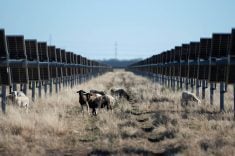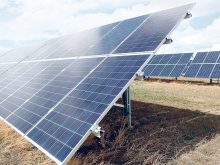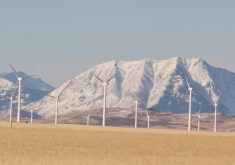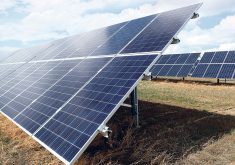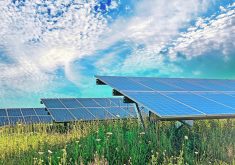The blue part of the spectrum that makes up sunlight is high energy, while the red part boosts plant photosynthesis
A study is seeking to spur the creation of solar panel technology that will reduce water use by crops while also generating clean, renewable electricity on the same farmland.
There doesn’t have to be a stark choice between solar projects and protecting agricultural land, said Majdi Abou Najm, co-author of the study and associate professor of soil biophysics at the University of California, Davis.
“We’re already in a planet with eight billion people, and we’re projecting to be 10 billion in less than 30 years from now… and we’ve started to see prime land being in competition between energy groups and agricultural groups, but it doesn’t need to be a zero-sum game.”
Read Also

Phosphate prices to remain high
Phosphate prices are expected to remain elevated, according to Mosaic’s president.
The study’s findings suggest the blue part of the spectrum that makes up sunlight has a higher energy that makes it better suited to produce solar power, while the red portion is more efficient for photosynthesis for plants, said Abou Najm.
Because red light conveys less energy, plants exposed to it experience lower temperatures and have less transpiration, he said. It means the plants will likely be less thirsty, “if you want to simplify that, and this will lead to similar yields, but at a lower water cost.”
Agriculture is the biggest consumer of water, he said. Boosting light and water efficiency could also improve carbon assimilation and soil health, said the study.
“This knowledge can possibly unlock the real potential of promising agricultural technologies that target optimization of light allocations such as agrivoltaics.”
Agrivoltaics refers to the practice of raising crops under solar panels. Abou Najm hopes his findings will inspire the creation of spectrum-splitting solar panels or modules that will use blue light from sunlight to generate electricity while allowing red light to shine through to the crops beneath.
“We’re working on a few contacts to actually develop modules that can be tested, and I’m already in contact with another startup who is developing a solution to that, and they want to test their samples with us.”
They cannot be identified because the work is still at the experimental stage, said Abou Najm, who is also a fellow at the UC Davis Institute of the Environment. “But I’m hoping that in a year or two, those panels can be tested on a larger scale in the fields.”
The study cautioned that further research needs to be done on the response of crops to different spectra of light. It said an analysis showed it can depend on the species being grown.
Different plants can be sensitive to environmental or crop variables such as air temperature, humidity, CO2 concentration and the amount of sunlight, it said. “Therefore, further research is necessary to assess which crops and climates are more suitable to optimize the proposed food-water-energy nexus.”
Besides computer modelling that replicated the response of plants such as basil, strawberries and lettuce, Abou Najm’s research involved light filters overtop small plots of tomato plants at the university’s agricultural research fields near Davis, Calif. The area near Sacramento has a Mediterranean climate, he said.
Crops such as wheat or barley have been seen as unsuitable for solar projects in Alberta because of the large size of the farm equipment needed to harvest grain. Producers have instead used grazing by animals such as sheep that won’t climb on or damage solar arrays.
However, Abou Njam said the height of the arrays could be raised to accommodate large farm equipment. Another advantage of mixing crops with solar could be to create extra revenue for farmers by selling renewable power to the electrical grid while helping reduce producers’ reliance on fossil fuels, he said.
“I think this will be the last piece in the puzzle to electrify our tractors in agriculture, so this can be also an incentive for growers to transition from diesel-using or diesel-derived tractors into electric ones.”
The arrays also could also help protect crops from hail or even frost, said Abou Njam. Data from his experiments show the filters resulted in a slight warming effect at night, although the research wasn’t continued into the winter, he said.
He said he would welcome collaborations with Canadian scientists for further research.
Bitter divisions are growing in rural Alberta over the construction of renewable energy projects such as solar on farmland, said Paul McLauchlin, president of the Rural Municipalities of Alberta, during an earlier interview.
A resolution passed Nov. 9 by the RMA at its fall convention in Edmonton asked the Alberta government “to work collaboratively on policy that will find a balance between the development of renewable energy and protection of valuable agricultural land.”
However, farmers need to think differently about sunlight and how it might be manipulated to maximize the productivity of their land by simultaneously growing crops and generating solar power, said the study.
“Humanity’s growing appetites for food and energy are placing unprecedented yield targets on our lands…. Co-generation can lead to sustainable intensification but requires a paradigm shift in the way we manage our resources, particularly light.”




